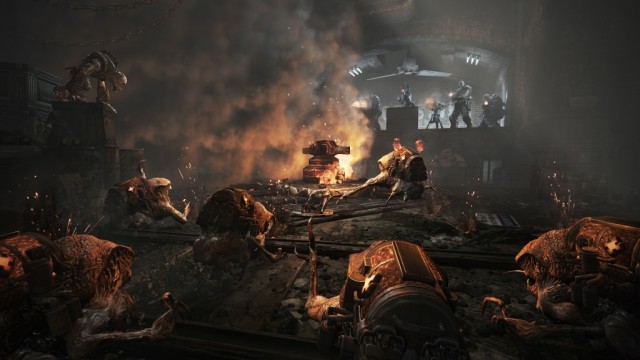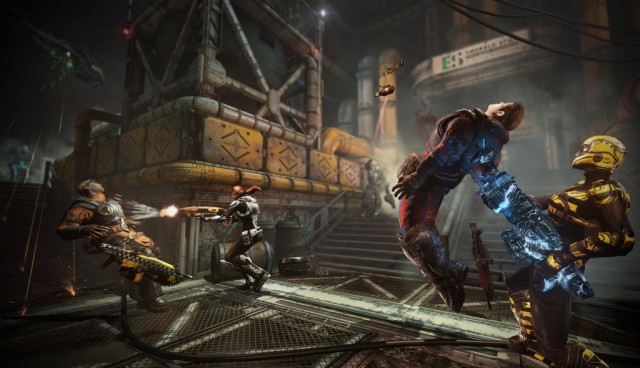
PCF faced a real tricky situation. Gears of War has always been somewhat of a guilty pleasure; it’s big, it's loud, it's dumb. But seven years and three games since its debut, the series is between a rock and a hard place. It can’t just keep pushing all the machismo and expletives the series is known for without feeling a bit stale. It also can’t alienate the fans who have built the franchise into the multi-billion dollar behemoth that it is. So Judgment mixes it up enough that the game feels fresh and new while retaining plenty of familiarity for series devotees. There are going to be people decrying the game because it isn’t the same as it always was, but they’re shortsighted and wrong.
New look, new controls, new mission structure
Gears of War always looks depressing; everything’s desaturated to the point of being nearly devoid of color. Gears 3 experimented with chroma here and there, but there were still extended sections of brown, gray, and rampant desaturation. It’s boring to look at and even more boring to play through for hours at a time.
Judgment, by contrast, is by far the most visually interesting game of the franchise, and it's constantly mixing up its visual themes. Primary colors flourish in almost every level, and paired with relentlessly shifting gameplay, it kept me interested and excited throughout. There's a strong, apparent influence from Bulletstorm, which had a rich, pulp-comic color palette to help set it apart from its boring, dingy earth-toned modern combat first-person shooter peers.
Again, Judgment still feels like Gears, but there are a few concessions made in the name of accessibility. This installment's controls feel more like a typical third-person shooter than a past Gears of War game. No, the active-reload meta-game hasn’t vanished, but the option to use the d-pad to switch between weapons has disappeared. There are other small interface changes, too: Judgmentlimits you to carrying two weapons and one grenade type at a time; grenades throw faster and are mapped to the left bumper by default; and ammo packs from enemies are picked up automatically.

Everything feels lithe and trim, but these changes can still be off-putting. The standard Gears controls have been hardwired into my brain over the past seven years, and even toward the end of Judgment I was still hitting the wrong buttons on the controller. I’m mostly OK with this, but it's a controversial decision that could divide the audience and even drive some away.
But the biggest change from Gears games past is how each mission is structured. Judgment eschews the traditional Gears progression: cutscene to walking-slowly-with-fingers-affixed-to-an-in-ear-communicator to blowing-stuff-up. Instead, we get a courtroom story featuring Kilo Squad, led by series fourth-fiddle Lieutenant Damon Baird, testifying before a military tribunal about their exploits. Each of the four members has their own testimony, narrating the action as the player follows along and pulls the trigger. Each memory follows a strict blueprint: a few lines of dialog set up the action, then players choose a difficulty or gameplay modifier, enter a room, and kill all the things. Afterward, a mission-recap leaderboard pops up. Rinse, repeat.
Each firefight is its own self-contained mission, taking between five and 15 minutes to finish. There are several battles per chapter and roughly seven chapters for each character’s testimony, adding up to just under 16 hours for my run through the solo campaign (your mileage may vary, of course). Unlike previous Gears games, there aren’t long bouts of running with nothing to shoot (these sections always made you realize just how lethargic locomotion is). The action is more or less constantly delivered to the player, and it hits fast and hard. This keeps the pace moving along at a fast clip that prevents the game from ever feeling like a slog to the next big encounter or set-piece.
That's partly because there aren’t any such big events. Save for the final boss fight, large-scale blockbuster shenanigans don’t exist in Judgment (and even that single boss is relatively small compared to what populated prior Gears games). It sounds like sacrilege for a series built on jaw-dropping scale and sheer spectacle to scrap these elements, but the payoff is a game that feels more even—each fight feels unique and important. I’ll take a consistent, awesome experience over an undulating grind through dull firefights punctuated by some drawn-out, massive boss battle any day of the week.
Memorable modifiers, forgettable story
Efficient play can unlock “Declassified” modifiers that alter the squad-member’s testimony, adding wrinkles to each “memory” and increasing the difficulty or altering the gameplay in some way. Opting to declassify an encounter nets you more mission-rating stars, which in turn unlock weapon customizations and character skins for multiplayer.
There's a good bit of variety and invention in the modifiers. They're never as one-dimensional as “enemies are impervious to ballistic weapons,” or the like. Instead, you get new challenges like “finish the area in under four minutes before the university’s poison gas defense goes off” or “strong winds kicked up dust, limiting visibility and making movement difficult.” Far from being tacked on, these modifiers end up adding a lot of replay value to what could have been quite monotonous.
Even without the modifiers, Judgment's mission structure is never dull. On one mission, Kilo squad has to take out snipers dug in to an elevated riverbank. After dispatching those goons, they huddle into a slow-moving and totally exposed freight elevator up the opposite side of the ravine, only to have snipers firing at them from across the river. Another mission features an extended mortaring sequence, and yet another throws in a Normandy Beach-style invasion for good measure. Did you like Gears of War 3’s tower defense infused Horde mode? There are a handful of missions like that here, too. Mission variety isn’t the exception in Judgment; it’s the rule.
Enemy types and locations aren’t static, either. Each time an area is played, the enemy types can vary dramatically. One time I was overrun by a pack of locusts riding on some grub-like beast of burden and had to reload the last checkpoint. Upon reloading, the enemy wave changed to a legion of rocket-launcher wielding Boomers, forcing me to change tactics and reappraise the situation. For a game with such a strong multiplayer focus, this will help keep the game fresh for a long time—especially if your co-op crew doesn’t care to battle against strangers online.
The story generally stays out of the way of the tight gameplay, but this may be because it's completely forgettable. This isn’t anything new for the series, but much was made of hiring Tom Bissell (journalist, author, and very vocal critic of narrative presentation in gaming) to writeJudgment’s script. After finishing the campaign and what amounts to an on-disc Gears of War 3 “lost” mission (tying Judgment’s new characters into Gears’ established lore), I was hard-pressed to recount anything remarkable about the story.
The dialog is slightly less infantile and expletive-laden this time around, but character development is practically nil. All I know about franchise newcomers Sofia and Paduk is that one is a super-green cadet and the other is a Cold-War era Russian caricature, respectively. And coverboy Baird? I can’t remember anything he did in the first three games, and I still didn’t know him any better or care about him any more after Judgment’s credits rolled.
Mixed Multiplayer

For those who argue that no one plays Gears for the campaign, here’s where I talk about multiplayer. The servers aren’t fully populated as I write this, so my pre-release experience is going to differ a bit from post-release online matches. That said, I grouped up with a handful of other members of the press or went solo with random strangers to sample each of the multiplayer suites.
Adversarial multiplayer’s shining star is “Overrun,” a mash-up of Horde and Beast modes from Gears 3 with a few twists. It's an asymmetrical class-based-objective mode pitting locust against human defenses. With each victory—or defeat—the teams move to a different location on a map. Humans have to fortify their bases in real-time against all variety of locust trying to destroy the objective. Each map is incredibly well-designed, with plenty of chokepoints and sections that play to the strengths of each locust enemy type. The diminutive Tickers can scuttle through crawlspaces inaccessible to other locust types and can generally make the opposing team have a very bad day, if used properly. Overrun scratches an itch I’ve had since my friends stopped playing Battlefield: Bad Company 2’s Rush mode a few years ago, and it's an itch I'll definitely keep scratching.
Plain old multiplayer Horde mode isn’t available in Judgment, which is all the more curious considering how many elements of the mode weave into the campaign. The new Survival mode doesn’t cut it as a replacement, either; it boils down to ten waves of Overrun against bots instead of human players. It's possible People Can Fly left the mode out because they felt they couldn't change it enough to feel like a proper innovation, but in that case, what was the point of carrying team deathmatch along for the ride? Free-for-all mode is COG-on-COG action that's as boring as it sounds, and it feels out of place in a series that’s always had a team-based or tactical bent.
People Can Fly’s take on Gears is unmistakable. It doesn’t feel like the Marcus Fenix trilogy that came before it, but this game's newness isn’t always for the better. Judgment’s outstanding gameplay comes at the expense of story, and for some that will be a major sticking point. Gears of War 3 was an over-polished AAA shooter designed for everyone to love, with nary a rough edge in sight.Judgment is riskier, and it's not afraid to flaunt its differences and its charms. But in many ways,Judgment feels hamstrung by legacy, regressing back to old patterns and behaviors. Instead of taking risks in story and multiplayer in the ways the campaign’s gameplay did, it feels like its parents are still around.
The Good:
- Faster gunplay and movement just feels better than previous games
- Wide color palette and mission variety keeps the game from feeling monotonous
- Overrun mode is an addictive blast
The Bad:
- Forgettable story and underdeveloped characters leave a lot to be desired
- Remapped controller functions seven years in take some getting used to
The Ugly:
- No Horde mode
No comments:
Post a Comment
Let us know your Thoughts and ideas!
Your comment will be deleted if you
Spam , Adv. Or use of bad language!
Try not to! And thank for visiting and for the comment
Keep visiting and spread and share our post !!
Sharing is a kind way of caring!! Thanks again!